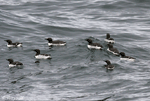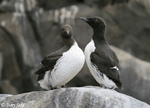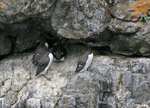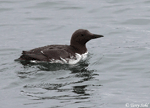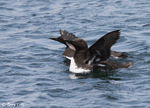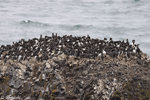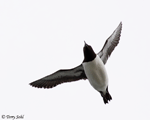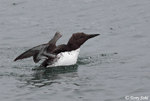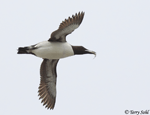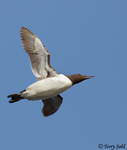| Length: 17 inches | Wingspan: 26 inches | Seasonality: Non-resident in South Dakota |
| ID Keys: Dark upperparts, light underparts. Head is all black in breeding plumage, white head with black cap and eyeline in non-breeding plumage | ||
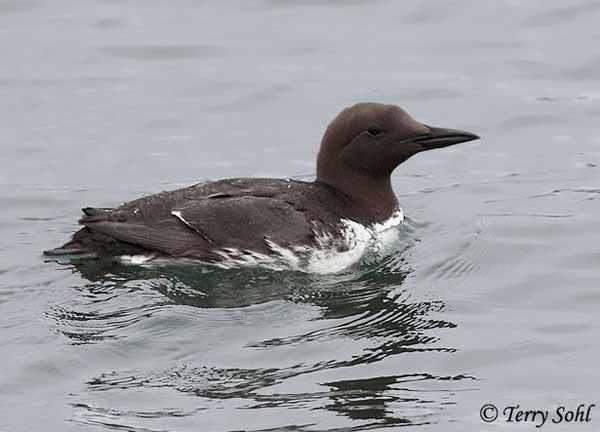 The
Common Murre is a large auk with a widespread distribution in North America.
They are widespread on the Pacific Coast from Alaska southward to Oregon and
California. On the Atlantic Coast they are less abundant and more
local, with most found around Labrador and Newfoundland. Common Murres
are considered to have the densest nesting colonies for any bird,
considering its size. Individual nesting pairs often are typically
within touching distance while the birds incubate their single eggs.
The
Common Murre is a large auk with a widespread distribution in North America.
They are widespread on the Pacific Coast from Alaska southward to Oregon and
California. On the Atlantic Coast they are less abundant and more
local, with most found around Labrador and Newfoundland. Common Murres
are considered to have the densest nesting colonies for any bird,
considering its size. Individual nesting pairs often are typically
within touching distance while the birds incubate their single eggs.
Habitat: During the summer breeding season, Common Murres are found on coastal islands and coastal cliffs and rock faces. At other seasons, they are found in cool waters, both close to the coast, and some distance out at sea.
Diet: Mostly feeds on fish, but will also feed on marine worms, squid, and small crustaceans such as amphipods and shrimp.
Behavior: Feeds by diving and swimming underwater, where they may reach depths of up to 150 feet.
Nesting: The nest of a Common Murre is...nothing! The egg is laid directly on a bare rock, typically on a cliff ledge but sometimes on a rock down close to the water. The female only lays one egg each year. Both the male and female help to incubate the egg. Both parents help feed and tend to the young hatchling. After a few weeks, the young is ready to leave the nest, and leaps and glides down to the water's surface, accompanied by the male parent. The male then tends to the young bird until it is able to fly.
Song: Silent most of the time, but on the nesting colony, makes a growling "grrrrrrr" sound.
Migration: They are permanent residents in much of their range. However, birds at the northern edge of their range are migratory (particularly in areas such as western Alaska where coastal waters freeze in winter), and there is some general movement southward on both coasts. Populations also disperse away from coasts in the winter, where they may be found relatively far out to sea.
Interactive eBird Map: Click to access an interactive eBird map of Common Murre sightings
Similar Species: Thick-billed Murre, Razorbill
Conservation Status: Populations have declined in some locations, but the Common Murre is still common in many areas with a widespread geographic distribution. The IUCN lists the Common Murre as a species of "Least Concern".
Further Information: 1) Audubon - Common Murre
2) BirdWeb.org - Common Murre
3) Alaska Seabird Information Series - Common Murre
Photo Information: Photo taken on June 6th, 2009 - Off the coast of Newport, Oregon - Terry Sohl
| Click below for a higher-resolution map |
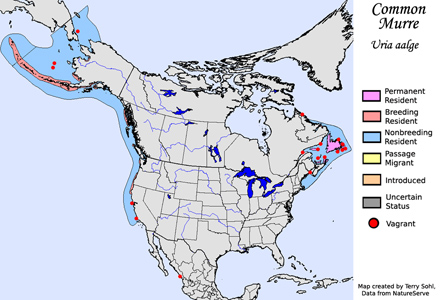 |
| South Dakota Status: Non-resident in South Dakota |
Additional Common Murre Photos
Click for a higher-resolution version of these photos


